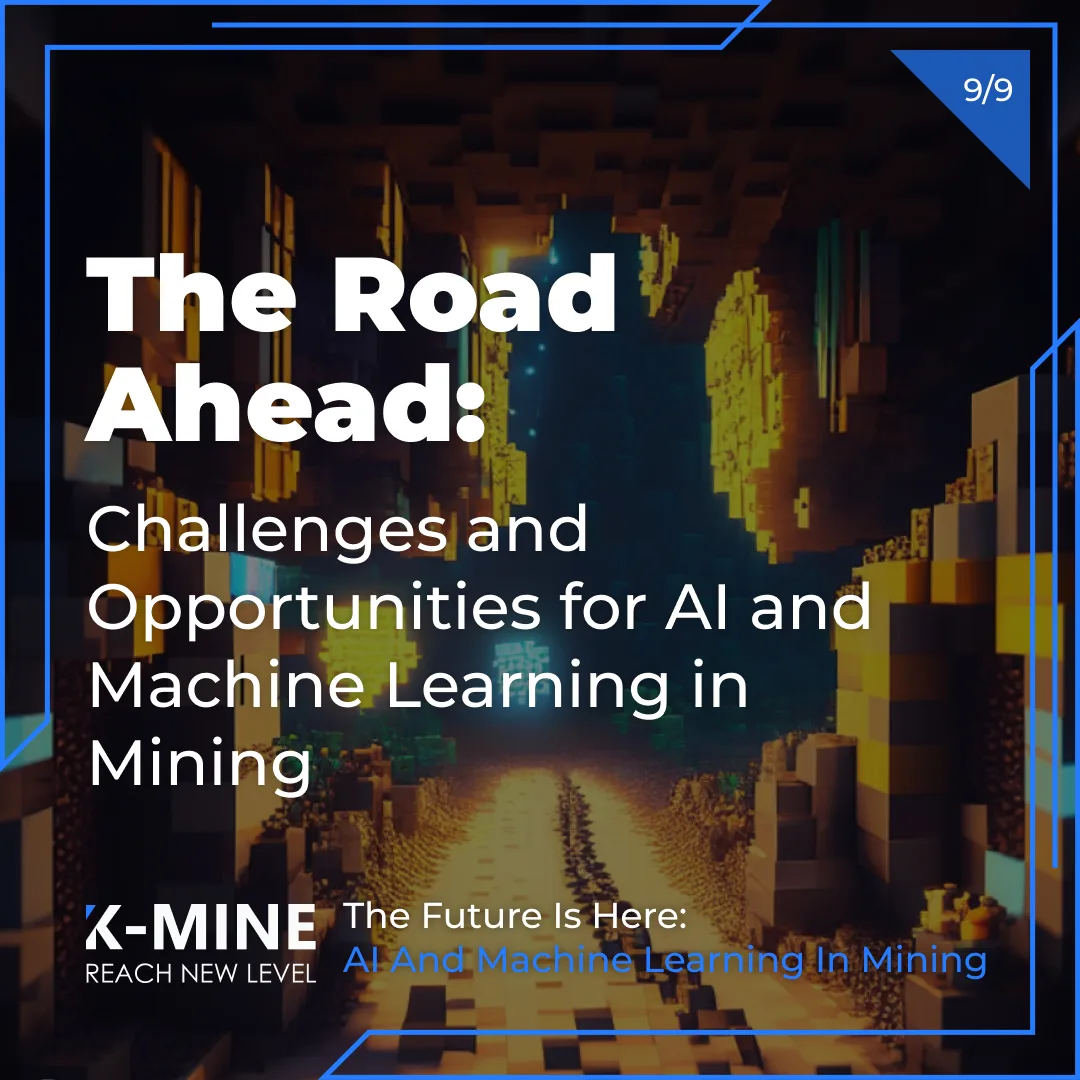
The Future is Here: AI and Machine Learning in Mining. Part 9Content
Welcome to the final part of our series exploring the intersection of artificial intelligence (AI) and machine learning with the mining industry. Over the past eight articles, we’ve delved deep into the transformative potential of AI in various aspects of mining operations, including mineral exploration, ore grade prediction, mine planning, equipment maintenance, and environmental management.
As we turn our gaze towards the future, it’s important to contemplate what lies ahead. How might AI and machine learning continue to evolve in the mining industry? What potential advancements could we see, and what challenges must we address to reach this promising future? Join us as we journey into the frontier of AI and machine learning in mining, mapping out the exciting opportunities and formidable obstacles that lie ahead. Our goal is to provide a comprehensive overview of the landscape, empowering stakeholders to navigate this complex and rapidly evolving field.
The Current State of AI and Machine Learning in Mining
Before we venture into the future, let’s first consolidate our understanding of the present state of AI and machine learning in mining, drawing upon the insights gleaned from our previous discussions.
Firstly, we’ve seen that AI and machine learning are revolutionizing the early stages of the mining process, namely in mineral exploration and ore grade prediction. Sophisticated algorithms are now capable of processing vast amounts of geological data to identify potential mineral deposits and accurately predict the grade of ore. This ability not only streamlines the exploratory phase but also aids in making informed decisions about the feasibility of mining operations.
In the realm of mining equipment, AI’s role is multi-dimensional. It enables autonomous operation of vehicles and machinery, enhancing efficiency and mitigating risks associated with human error. Additionally, predictive maintenance powered by machine learning is reducing equipment downtime, boosting operational efficiency, and ultimately saving costs.
In mine planning and scheduling, the potential of AI is just beginning to be tapped. Optimization algorithms can devise the most profitable extraction sequences, while predictive analytics can help anticipate and manage logistical challenges.
AI’s role extends to safety and risk management as well, aiding in predicting safety incidents and fostering a culture of safety. The technology is also making its mark on environmental, social, and governance (ESG) initiatives, particularly in predicting and managing environmental impacts, underscoring its role in sustainable mining practices.
From these insights, it’s clear that AI and machine learning have already begun to infiltrate various aspects of the mining industry. But this is only the beginning; the potential for future growth and development is immense. In the following sections, we will delve into the opportunities and challenges that lie ahead.
Potential Future Developments
Looking ahead, the horizon is filled with exciting possibilities for the application of AI and machine learning in the mining sector.
One likely development is the increasing integration of AI throughout all stages of the mining process, creating a more interconnected and automated system. This would involve deeper collaborations between AI systems and human operators, leading to the development of more sophisticated decision support systems. The result could be a significant leap in operational efficiency and a reduction in human error.
Machine learning models are expected to become increasingly accurate as more data becomes available, leading to improved predictions in areas like mineral exploration, ore grade prediction, and safety incident forecasting. We could see the rise of more advanced geostatistical modelling techniques, potentially improving the precision of mineral exploration.
The application of AI in predictive maintenance is also set to grow, with advancements in sensor technology and data processing capabilities allowing for even earlier detection of equipment issues. This could further reduce downtime and extend the life span of expensive machinery.
In terms of safety, we could see the development of AI systems capable of real-time monitoring and alerting, providing instant warnings about potential hazards and allowing quicker responses. These systems could incorporate a range of data, from equipment performance statistics to real-time video feeds.
The use of AI in ESG initiatives is also likely to expand, with AI-powered tools helping to monitor environmental conditions, predict impacts, and guide mitigation efforts. As sustainability continues to be a focal point for the industry, these tools will become increasingly important.
These are just a few of the potential developments we might see in the near future. However, the full potential of AI and machine learning in the mining industry is far from being fully realized, and the journey towards it will not be without challenges.
The Challenges Ahead
While the future of AI and machine learning in mining is promising, it is not without challenges that need to be addressed. One of the primary obstacles is data quality. AI and machine learning models are only as good as the data they are trained on. Mining companies will need to ensure they have robust data collection and management systems in place to facilitate the development of accurate and reliable AI models.
Another significant challenge is the integration of AI systems into existing operations. Mining operations are complex and involve many interconnected processes. Successfully integrating AI systems without disrupting these processes will require careful planning and execution.
Change management is another critical aspect. AI and machine learning will change the way many jobs are done, and this could lead to resistance from employees. It will be important for mining companies to effectively communicate the benefits of these technologies and provide training to help employees adapt to the new ways of working.
Furthermore, ethical considerations are of increasing importance as AI and machine learning models gain more autonomy in decision-making processes. Developing guidelines for AI ethics, ensuring transparency in how models make decisions, and establishing accountability measures for when things go wrong will be crucial.
Lastly, regulations and standards for the use of AI in mining are still evolving. Mining companies must keep abreast of regulatory developments to ensure compliance and avoid potential legal and reputational risks. In some cases, they may also need to work with regulatory bodies to help shape the future rules of AI in mining.
Overcoming these challenges will require a concerted effort from all stakeholders. It’s not a journey that can be made alone; collaboration between technology providers, mining companies, employees, regulatory bodies, and other stakeholders will be essential. Despite the challenges, the potential benefits make the journey worthwhile. The future of mining could be more efficient, safer, and more sustainable with the help of AI and machine learning.
Opportunities for AI and Machine Learning
Challenges often serve as catalysts for growth and innovation, and in the case of AI and machine learning in mining, this rings particularly true. These obstacles, while complex, provide an abundance of opportunities for advancements and improvements in the field.
Firstly, the challenge of data quality offers an opportunity to refine data collection and management strategies in mining. This can potentially lead to the development of more robust and precise AI models. Additionally, the push for better data quality can lead to a greater overall understanding of mining operations, as teams must fully comprehend all aspects of the process to gather useful and high-quality data.
Integration issues present an opportunity to develop better and more efficient systems that incorporate AI into mining operations. These could lead to the creation of new jobs, innovative solutions, and more streamlined processes. It also gives the mining industry a chance to rethink and reimagine traditional methodologies.
Resistance to change and the need for change management strategies open avenues for improved communication and training systems within mining companies. Through the right strategies, mining companies can foster a culture of continuous learning and adaptability that extends beyond the implementation of AI.
In terms of ethical considerations, the opportunity lies in leading the discussion and development of ethical guidelines for AI. As pioneers in this field, mining companies and tech providers can help shape a future where AI is used responsibly and ethically in an industrial context.
Finally, the evolving nature of regulations and standards presents an opportunity to take part in shaping the future of the mining industry. By actively engaging with regulators and standards bodies, mining companies and technology providers can ensure the creation of a balanced and effective regulatory environment.
The challenges in integrating AI and machine learning in mining are indeed substantial. However, they also present significant opportunities for learning, growth, and innovation, setting the stage for an exciting future.
Looking Forward: The Role of AI in the Future of Mining
As we look toward the future, it becomes clear that AI and machine learning will continue to play a pivotal role in the evolution of the mining industry. With potential developments and opportunities abound, these technologies stand to further revolutionize the industry in many ways.
In terms of operational efficiency, we can expect AI to be integrated more fully into various mining processes. From predictive maintenance to extraction sequencing, AI’s ability to analyze vast amounts of data and make accurate predictions will continue to streamline operations and reduce costs. With advancements in data collection and integration, these applications of AI will become even more precise and effective.
In the realm of safety and risk management, AI and machine learning will further improve their ability to predict incidents and mitigate risks. Through advanced algorithms and deep learning, these technologies can learn from previous incidents to predict and prevent future ones. As such, mining operations will become increasingly safer, and a proactive approach to safety will become the norm.
As for ESG initiatives, AI’s role in environmental management is set to expand. With the ability to predict environmental impacts and aid in remediation efforts, AI will play a critical role in ensuring the mining industry meets its ESG commitments. It will also help mining companies operate more sustainably, reducing their environmental footprint and improving their social impact.
Furthermore, the challenges presented by the integration of AI in mining operations will drive innovation in the sector. As mining companies strive to overcome these obstacles, new solutions and technologies will be developed, pushing the boundaries of what’s possible in mining.
Overall, the future of mining, buoyed by the advancements in AI and machine learning, promises to be safer, more efficient, and more sustainable. The integration of these technologies is not a mere trend but an integral part of the mining industry’s journey towards a more innovative and responsible future.
Conclusion
As we conclude our exploration of the impact of AI and machine learning on the mining industry, we find ourselves standing at the precipice of a new era, one marked by remarkable innovations and transformations. From refining operational efficiencies to enhancing safety measures, from enabling more robust environmental management to anticipating and mitigating potential risks, AI and machine learning have proven to be indispensable allies to the mining sector.
The current state of AI in mining paints a promising picture, marked by improved productivity, cost-effectiveness, and safety standards. Yet, it’s the horizon that compels our attention. The future holds immense potential, teeming with advancements that could reshape the landscape of the industry.
However, the path ahead is not without challenges. Data quality, system integration, and ensuring ethical AI use are among the hurdles to overcome. Yet, it’s these very challenges that open the door to innovation and continuous improvement, turning obstacles into opportunities for growth and learning.
This series began as a journey into the applications of AI and machine learning in mining. As we stand at its conclusion, we see it has transformed into something more – a preview into a future where technology and human ingenuity converge to create a safer, more productive, and more sustainable mining industry. And while the end of this series marks the end of our current exploration, the journey of AI and machine learning in mining is just beginning. The road ahead is long, filled with opportunities and challenges alike. But one thing is clear – the future of mining, with AI and machine learning at its helm, holds promise and potential like never before.



 Back
Back